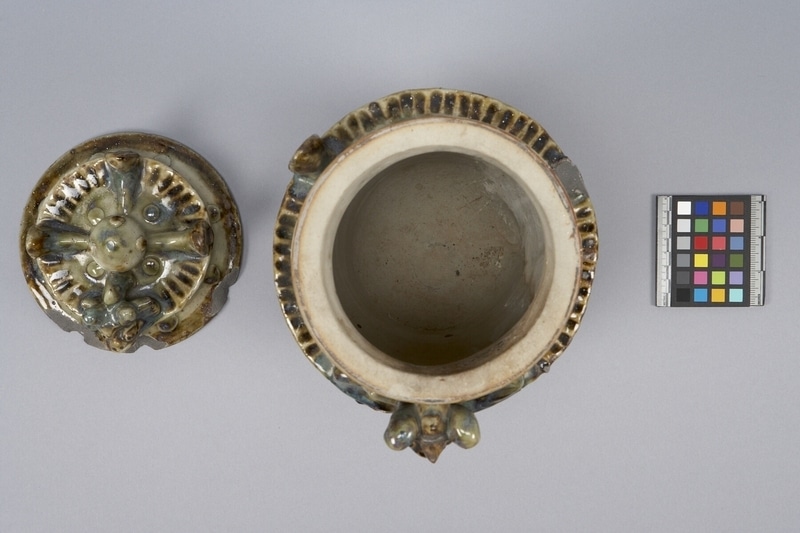Urn Item Number: N2.1052 a-b from the MOA: University of British Columbia




Description
Two piece urn, with body (part a) and lid (part b), both with a dragon head called ryūtō (龍頭) as well as floral motifs on the sides. Beige ground, with mottled turquoise, brown and green glazes. On the front side are holes associated with an empty space for affixing an epitaph panel (migachi).
History Of Use
Known as jiishigaami or jīshigāmi (ジーシガーミ) in Okinawan and zushigame (厨子甕) in Japanese. The empty space on the front side would normally hold an epitaph, called migachi or miigachi (ミガチ/ミーガチ/銘書) in Okinawan. Okinawans used to practice shinkuchi/senkotsu (シンクチ/洗骨/ bone-washing) as a form of reburial, and the washed bones were placed in such urns. Historically, the deceased were either left in the open air or placed in a large family tomb during the first period of internment. After several years the family would gather and clean the bones before placing them in jiishigaami (ジーシガーミ). Okinawa (沖縄) was ruled by the Ryūkyū ōkoku (琉球王国/ Ryūkyū kingdom) from 1429 until 1879, when Japan annexed the island. Trade with Japan, China, Korea, and Southeast Asia influenced social practices in Okinawa, but distinct cultures in the archipelago remain vibrant.
Cultural Context
funerary urn
Narrative
Most of the Okinawan items in the collection at MOA were collected by Wayne Suttles, who was recruited into the US Navy in 1941, soon after he finished his first degree, and was posted to Okinawa as a Naval Japanese language officer. While stationed there, he conducted research related to Okinawa culture and language.
Item History
- Made in Okinawa, Japan before 1954
- Collected by Wayne Suttles during 1954
- Owned by Wayne Suttles before 1954
- Received from Wayne Suttles (Seller) and University Purchase (Funding source) during 1954
What
Who
- Culture
- Okinawan
- Field Collector
- Wayne Suttles
- Previous Owner
- Wayne Suttles
- Received from
- Wayne Suttles (Seller) and University Purchase (Funding source)
Where
- Holding Institution
- MOA: University of British Columbia
- Made in
- Okinawa, Japan
When
- Creation Date
- before 1954
- Collection Date
- during 1954
- Ownership Date
- before 1954
- Acquisition Date
- during 1954
Other
- Item Classes
- ceramics
- Condition
- fair
- Current Location
- Case 82
- Accession Number
- 2171/0131 a-b